I've owned and even built a few slotload iMacs in my days of playing with Macs.The first was a bit of a test of the water to familiarise myself with the platform back in the mid 2000's. I had an early iMac DV Indigo with a blown flyback transformer, an iMac 350 Indigo that functioned, and a 350 Blueberry minus the logic board, also with a blown transformer... a fairly common condition on iMacs that see many hours of use. I basically wanted an iMac DV souped up a bit, and in Blueberry, not boring, mainstream Indigo... I had been charged with the task of keeping a whole lab of indigo machines (including the very DV i was about to dismantle) functioning in High School, so was thoroughly sick of the colour. The iMac DV differs from the 350 machine in having a 400mhz CPU, a DVD-ROM drive, dual-firewire ports, and an external VGA socket behind a removable flap on the rear. the 350 has the rear flap but no port or corresponding hole in the RF shield, no firewire ports (so virtually no way to connect external drives as USB1.1 is far too slow), and only a CD-ROM reader. In a nutshell, I used a process of trial and error to part out the trio of machines and reassembled them such that I had the logic-board, DVD-ROM drive and RF shield of the busted DV mounted in the chassis with the working analog board that was formerly a 350, which was wrapped in the Blueberry case plastics of the non-functioning 350, and had it running a 20Gb drive I'd sourced from a dead iMac somewhere else. It was satisfying... and the machine became known as Frankenmac.
As a teenager however I had always wanted a brand spanking new iMac DV SE when they were released... They were the upmarket top end of the iMac line in 2000, running at 500mhz with a 512k L2 cache, with a 30Gb HDD standard, 128Mb RAM and a DVD-ROM drive, and available in either pristine Snow, or sexy, sexy, professional as all get-out Graphite like the Powermac G4's of the time. They were both equally sexy and very capable for their time. The snow and graphite colours were rereleased later (graphite was also available previously in the upspec iMac 400 DV SE), but snow seems the most common, and graphite the most sought after.
The mac bug bit again in 2011 when I procured a couple of damaged Snow iMac 600's (Summer 2001 models), and a bunch of iMac 500 Indigos. With this came my most recent build... a Snow 600 known as Frankenmac II, built from the best-working 500 chassis, the better set of Snow case plastics, the 600 logic board from one of the Snows, a DVD drive from a DV that had bitten the dust and caught fire, a healthy 60Gb HDD from an eMac that had been handed over with the lot of iMacs, and had it maxed at a full 1Gb of RAM. This more than satisfied my longheld desire for a shiney Snow iMac. To many the iMac is throwaway technology... but to me, they are a beautifully styled, functional computer that single-handedly pulled Cupertino from the doldrums and changed the direction Apple, and indeed personal computing, would take forever, just as the Macintosh did in 1984. The iMac is a huge part of Apple history and indeed computing history and as such, deserving of preservation and recognition, just like it's great grandfather from the days of monochrome screens and bad Hall and Oates video clips.
Anyway, back on track.... I've always wanted a Graphite, even more than a Snow. My English teacher in high school, Miss T... also rather the Mac nerd, would gloat constantly about her then spanking new Graphite 400 DV SE affectionately named "Orac". Unfortunately I wasnt going to get one back then as I had already spent a fortune on a Powermac G3, which being still a far more capable machine for my purposes, made it hard to justify to my parents why I needed an iMac. Fast forward a decade and a bit and I had realised that the Graphite machines are actually quite a rarity in this country, moreso in working condition 12 years later, and are still actually somewhat sought after, and as such, most people who get them in amongst bulk lots of Indigo's from old school inventories want drug money for them on eBay etc.
Needless to say when I found this seemingly intact example of a Graphite DV SE in the bottom of my brothers wardrobe, which had been left by my other brother when he moved out of home and forgotten about, and which appparently had spent most of its life in a high school store room, I wasted no time in requesitioning it. It seemed basically intact at a cursory glance but for some scuff marks, However after I inspected it closer, I realised that in typical DET form, when it came time to dispose of it among other old equipment, it would appear to have been roughly handled, quite possibly dropped, meaning the internal chassis plastic is demolished. Not just cracked due to it being brittle, but completely falling to pieces in chunks... when I removed the case plastics the thing fell apart. In addition, it was missing the hard drive which i believe is my brothers doing, but oh well.

So, cutting to the chase, I made the decision to rebuild it...I opted to use the existing chassis with the CRT and PSU which to my knowledge were functioning and had low hours, and set about replacing the smashed structural plastic with stuff from one of my junker iMacs, in this case an iMac DV that was formerly my jukebox until my drunken housemate spilled American Honey in it. Anyway... the build went something like this....
This was the Graphite in the initial stages of dismantling... Note the yellowed piece of plastic inside the lower tray. That was the top of the inner-bezel that was broken clean off. The entire bezel ended up in about 50 pieces on my floor as soon as I took apart the outer shell...
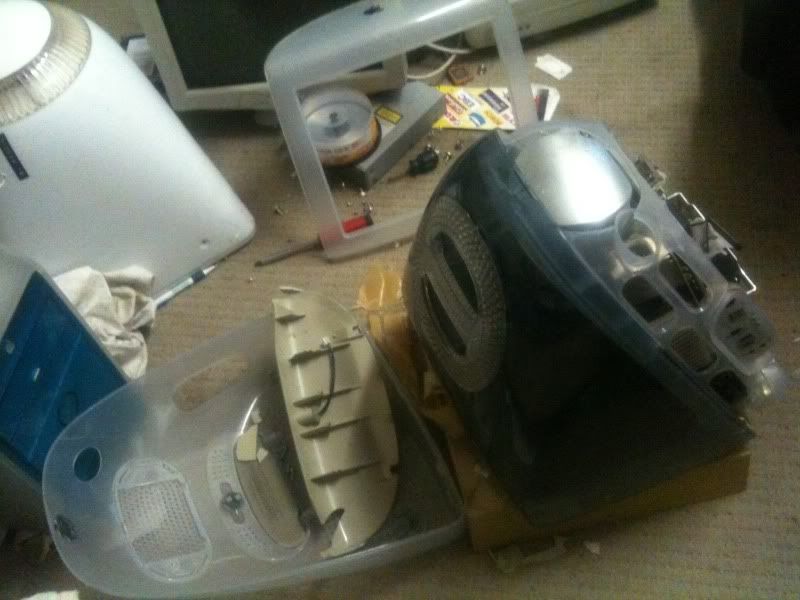
These were a fairly impressive set of specs back in mid-2000...
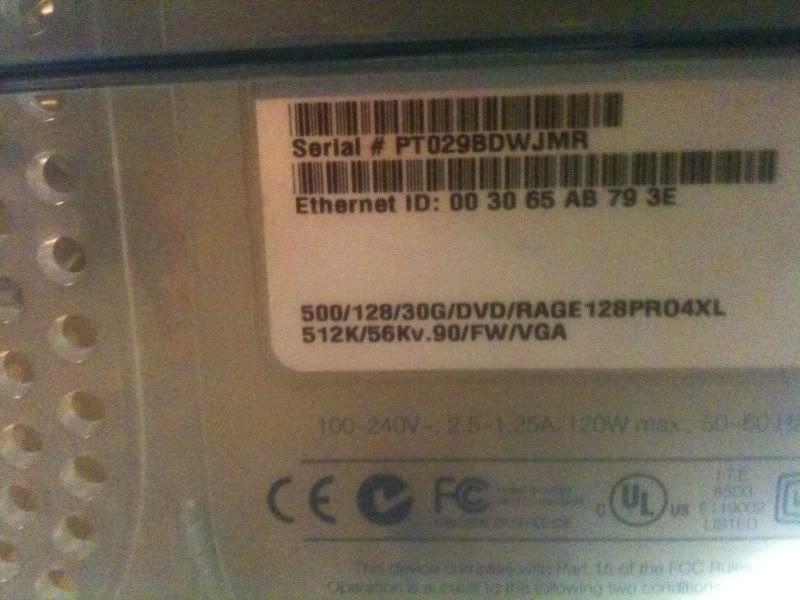
And heres the donor Indigo iMac DV 400 that met an unfortunate demise due to alcohol, which was to provide a mint condition inner-bezel. Luckily for me I had part-stripped it so it was easier than it could have been...
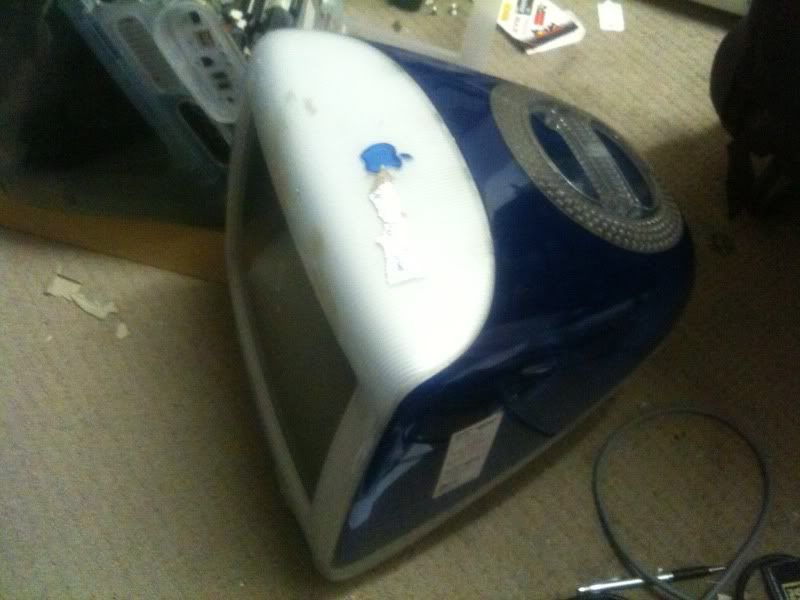
8 screws later and the Graphite looked like this...

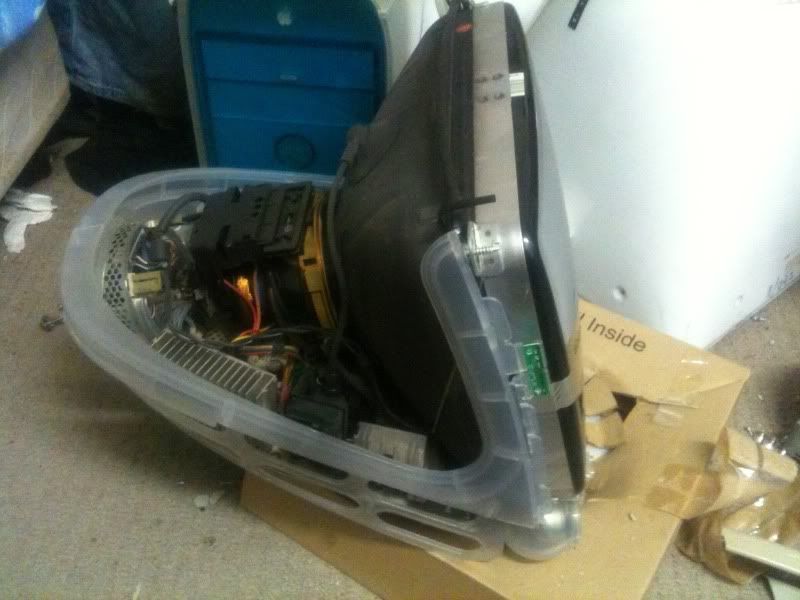
Whilst I had the two bezels detached, I thought I'd take a picture of them together to illustrate the difference between the early and late model items...

The complete bezel is from the donor machine shown above, a very early iMac DV (yellow power LED) that was running almost permanantlly its entire life in a school computer lab. The broken one is from the later iMac DV SE that hardly saw any use it seems. Tho identical parts they appear to be two entirely different plastic compounds... the later one being far more brittle and prone to breakage and fatigue and subject to very noticable deterioration. When taking the screw caps out of the late bezel, it is quite common for them to crumble or snap, and its also enevitable that the clips for the removable bottom tray will snap when it is removed after some use. The earlier one however, is a far more durable and flexible plastic that seems to deteriorate very little if at all with age, doesnt yellow over time, and most importantly, resists breakage during removal of case plastics or as a result of less than couth handling, or even just general movement. Having pulled apart many different iMacs, this appears to be an actual variation in manufacture... All 500 and 600mhz iMacs I have had apart appear to have the yellowed brittle plastic inside, whilst all 350s and 400s Ive had apart have the nice, pliable grey plastic.
And now this is with the new bezel in place place. Below that are a couple of photos of the screws that need to be removed to take the bezel off as well. Whilst it seems straightforward, these screws create headaches... These headaches become obvious when you unscrew them.
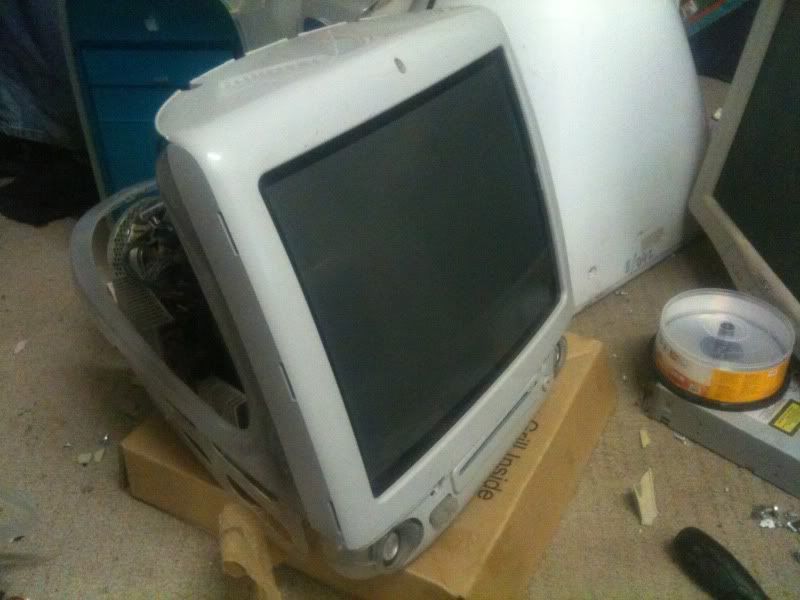
Top CRT/bezel screws... The bezel screw is in line with the rounded notch in the plastic, the CRT one is the big washered one at the top. My apologies for the shit iPhone camera and it's retarded light adjustment.
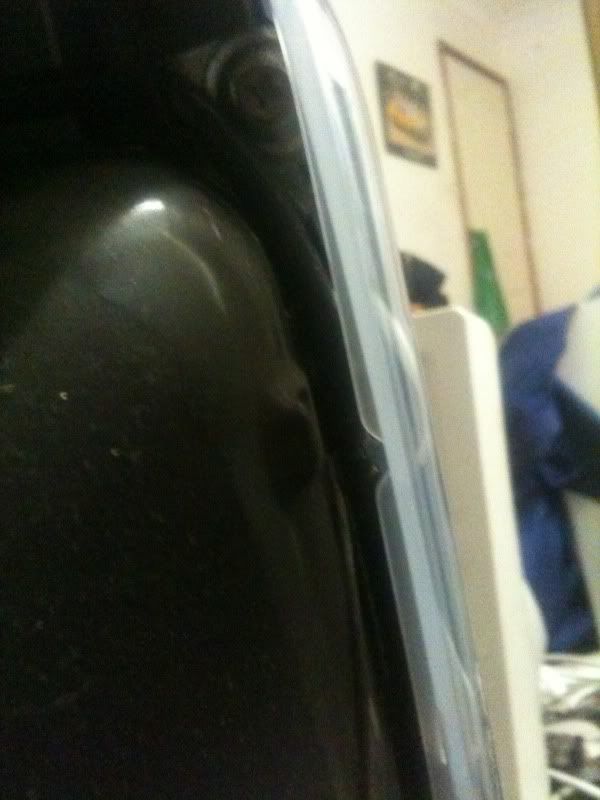
And here's the bottom screws...
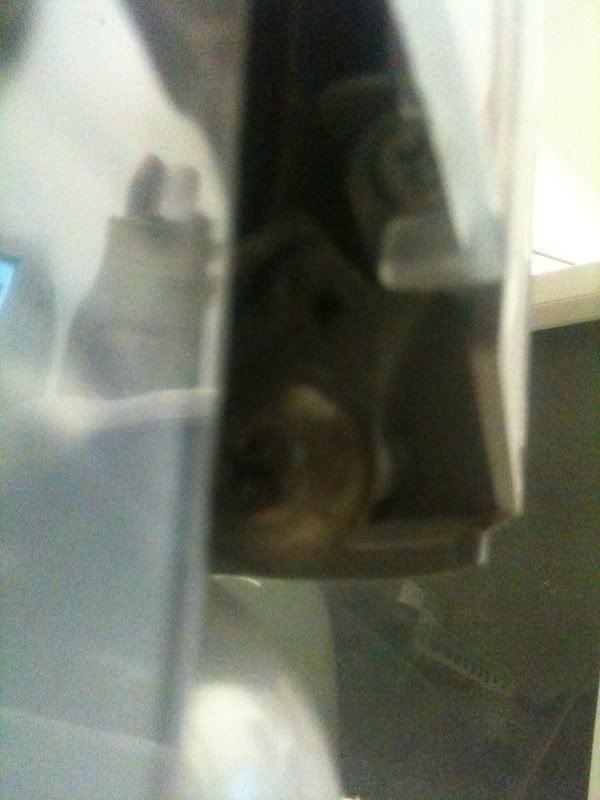
Then for the outer casing... First the top BACK cover goes back into place, despite all indications to the contrary. The screws are shown below in case anybody wanted to know. Two down each side, two at the top covered by a plastic cap each, and one in the rear behind the back of the CRT with a plastic spacer permanently attached.
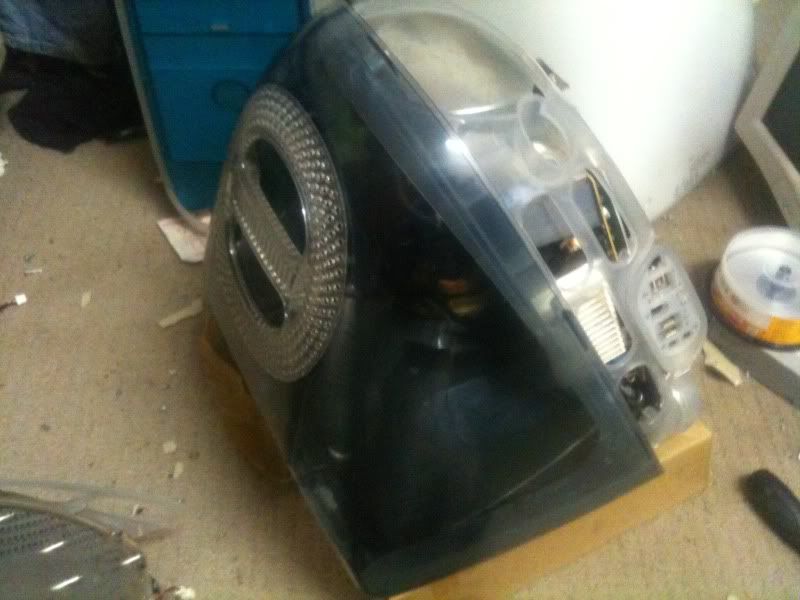
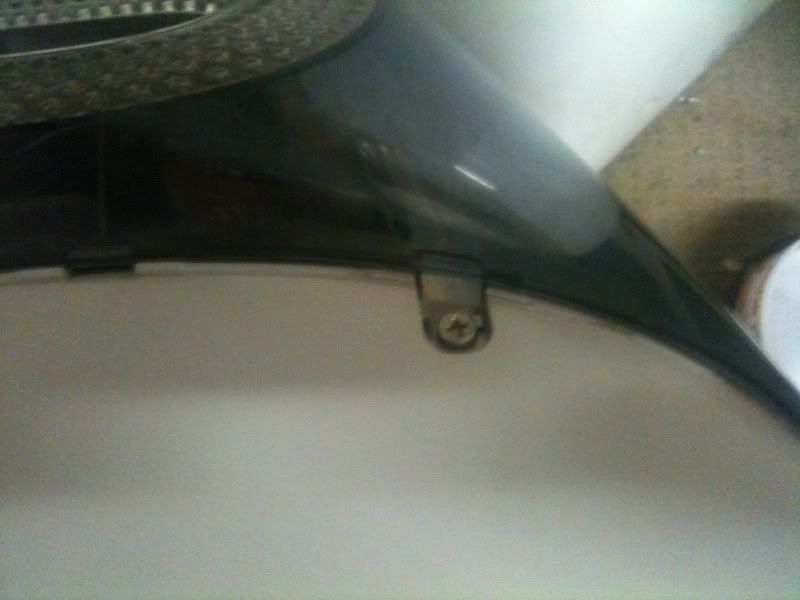
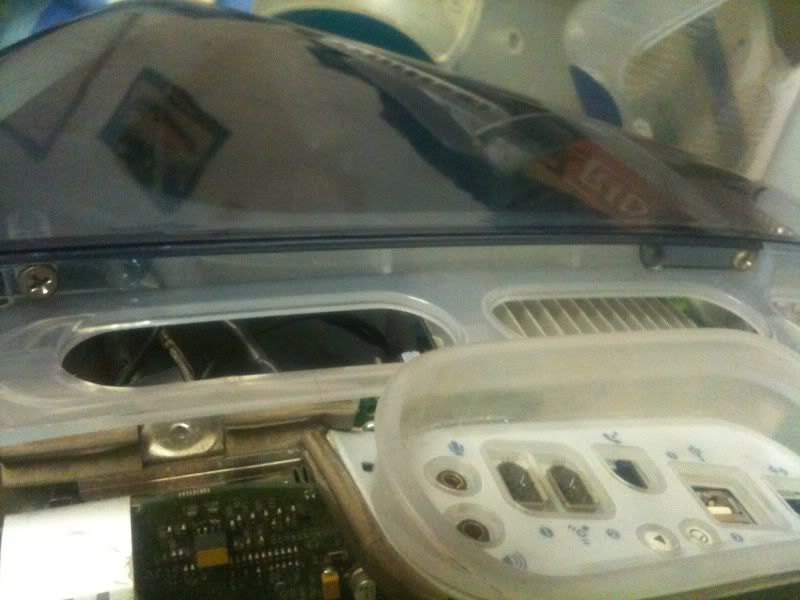
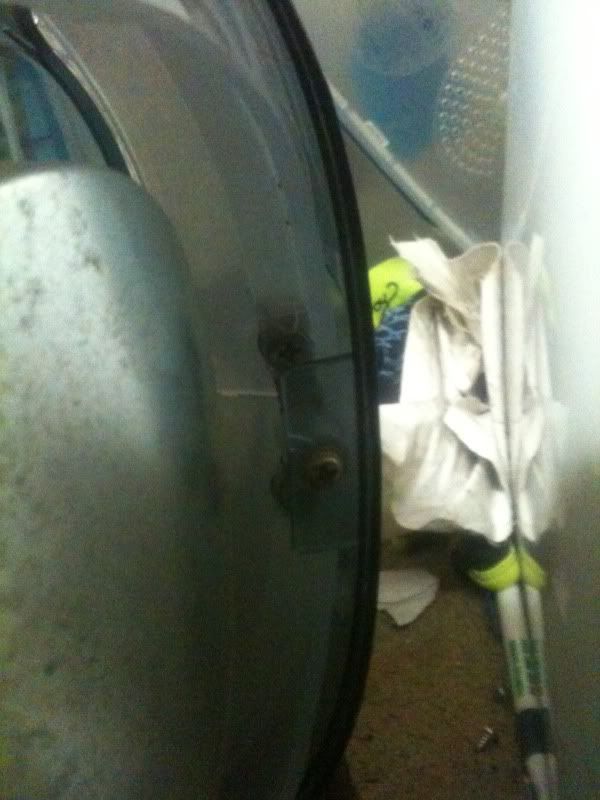
And then after that, the front outer bezel gets clipped into place and a pair of screws at the bottom hold it in place and get hidden by more plastic caps.

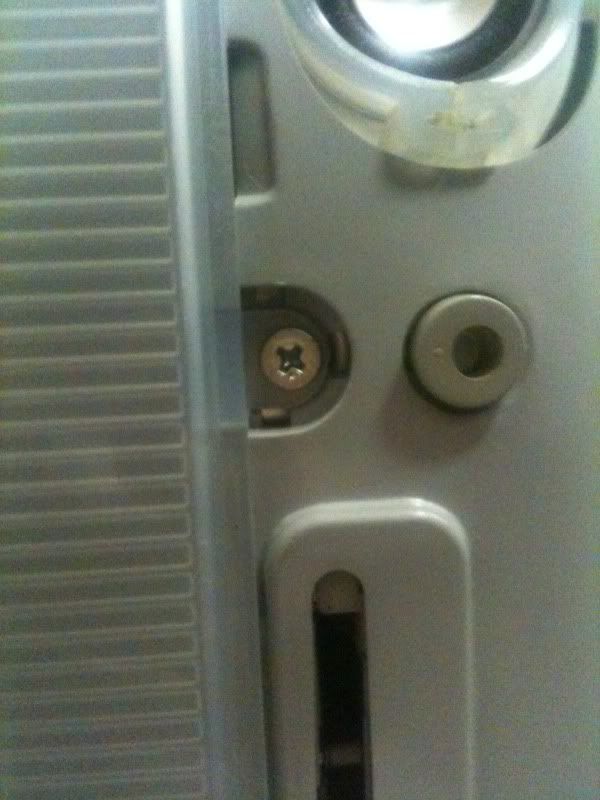
Finally, the bottom tray goes back on and I now have me a non-smashed Graphite iMac again.
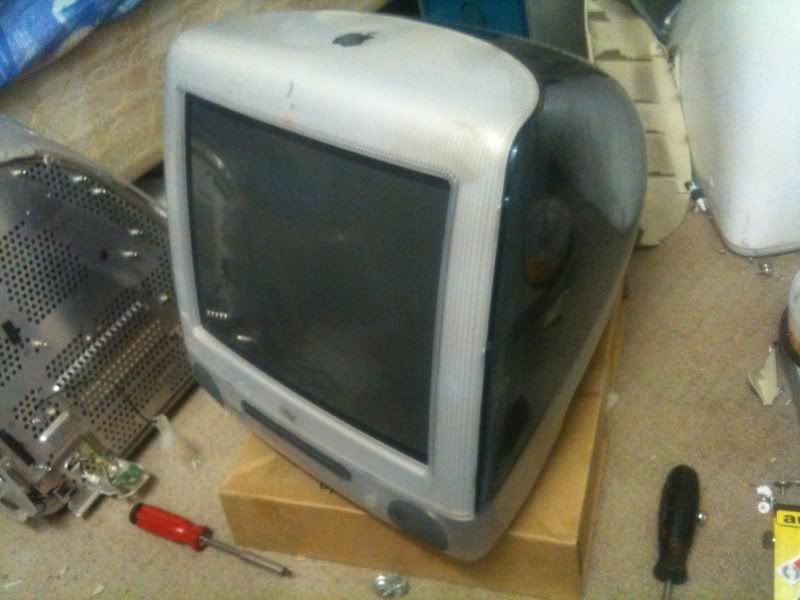
After that it was time to RAM it up and boot into Open Firmware to suss out the firmware revision before placing a boot drive in. This is of particular importance before putting in any drive that may contain a bootable OSX volume, including bootable OSX CD's. The reason for this is that the iMac G3 slotload models require Firmware revision 4.1.9 in order to run OSX. If FW 4.1.9 is not installed, you will get an error when you try to install OSX... but that is not the worst of it. Booting into OSX with firmware prior to 4.1.9 will rouse a video incompatibility (which was fixed by the 4.1.9 update, and was documented, albeit poorly, by Apple) that will generally cause your display to either do strange things and eventually fail, or just simply not show at all. On some rare occasions there will be no immediate symptoms, however over time the overstressed video circuitry will cause the display to degrade til it's unusable. The only way to fix this is to install the firmware update... if you have an iMac DV you can boot with an external monitor on the VGA port at the back and then install the update. If you have a 350 however, then it becomes a monumental headache which can be dealt with but I shall not go into detail with here. Usually the firmware update will fix the issue, however there are some cases where the video hardware has suffered permanant damage from running in an unsupported mode... so please for the sake of your iMac, dont take the risk!
Anyway, I had a dodgy bootup with RAM beeps to start with, but after swapping in a different stick of SDRAM, it booted right up to a flashing mac icon....
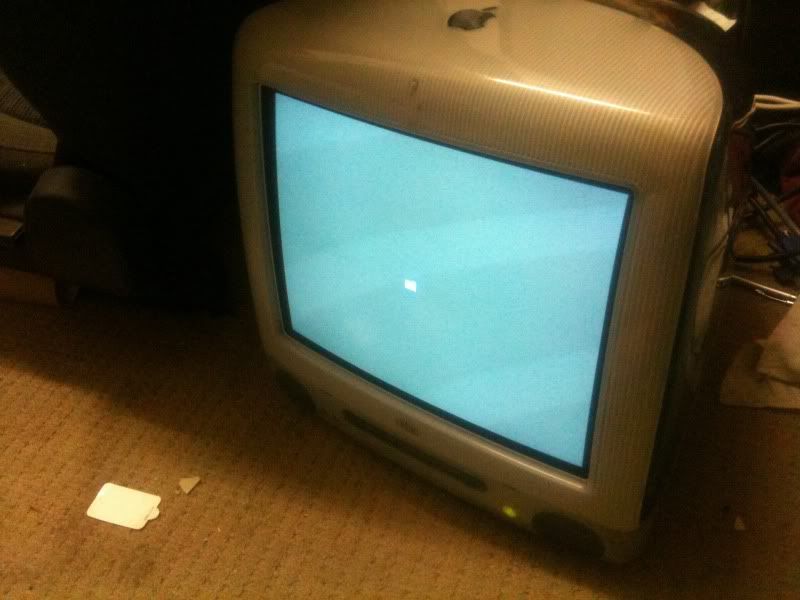
After ascertaining it would power on, indicating initial success, a reboot into Open Firmware told me it was running Firmware 4.1.7, so an update would be required before booting OSX... I have a 10Gb HDD out of an iMac DV with OS 9.1 and a copy of the Firmware Update package installed on it specifically for this purpose, so in it went, and that is where things went pearshaped.Whilst the iMac booted up just fine, it had somehow in the time between bootups developed an unusual issue whereby the display raster was tilted quite badly to the left. Geometrically it seemed basically fine, and purity and convergence seemed normal which seemed to rule out any major analogue video circuitry faults, however the display was rotated to the point where the corners were actually outside the maximum viewable area of the screen. It was skewed to the point where even at the maximum adjustment possible with the software geometry control panel in OS9, it was still wildly rotated. After a bit of research and deduction, I ascertained that the impact that had necessitated the rebuild in the first place had probably caused the deflection yoke on the neck of the CRT to be shifted out of allignment, creating the twisted display I was experiencing... This was both the news I wanted to hear, and the news I didnt want to hear. If this was the cause of the troubles, it was an easy fix. A simple case of loosening the glorified jubilee clip that holds it in position and twisting it back around the neck into the correct allignment. However that meant making contact with a CRT component, which is a positively frightening prospect by any stretch of the imagination... the operating voltage of a typical CRT screen is around 20,000 volts, and even at rest, they can store 2000 volts and shock you with enough current to kill instantly on contact in certain parts, and this charge can be stored for months or even years after the component is de-energised... For this reason I'd advise not to go near one if you are the slightest bit unsure of what you are doing. AFter doing some more intensive cross-referenced research on the composition and operation of a CRT, and then equally intensive research on servicing procedures from a number of sources, I ascertained that in this specific instance, the component I was concerned with was relatively safe, however to make 100% certain I took all the usual precautions... insulated my non-conductive screw-driver from thbottom of the shaft to the top of the handle with insulating electrical tape, wore rubber shoes, stood in a carboard box, moved all possible earths out of the way, removed my ring, put one hand behind my back, and went for gold...with the computer off and unplugged for a number of days mind.
So, anyway, after a simple (and ever so careful so as not to die) adjustment of the deflection yoke, I have more or less cured the display misallignment, with only a couple of minor H,V and R adjustments from the control panel being needed to get it squared up and centered where I wanted it. Next time i have the plastics off i will probably make a couple more yoke adjustments and see if i cant get it squared right up without any adjustment from the control panel needed at all.
So here it is currently still running the OS9 test drive.... no more twisted picture.

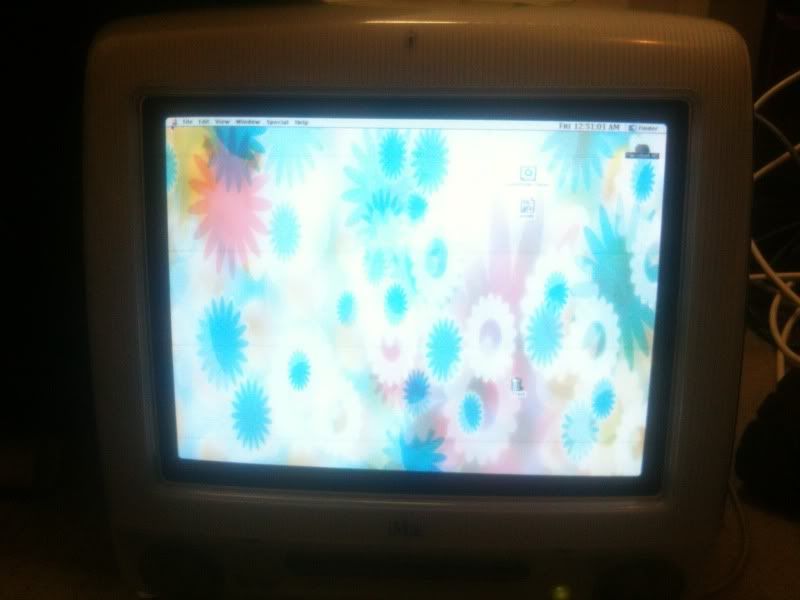
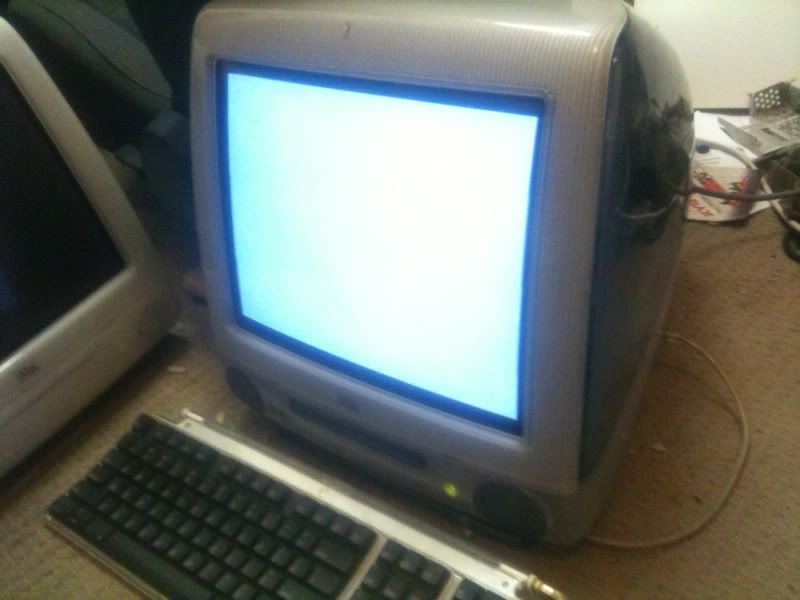
And that, people, is the story of how I restored an iMac and finally filled a hole that has existed in my collection that has existed for over a decade. I know most probably havent gotten to this part of the post without falling asleep, but if you have... kudos. Grab yourself a cookie. hehe
As an aside, this machine is getting a decent sized hard drive put in it, from the 60-120 mark, 120 being about the biggest it will support, being maxed out with 1Gb of RAM like the Snow currently is, and there is still a possibility that I may opt to swap out the 500mhz logic board with an 8mb video controller for a 600mhz board I have spare which came with 16mb of VRAM. The trade down is that the 600 only has 256k L2 cache, vs 512k L2 on the 500 board. Also for the sake of heritage, I may still keep the 500 board in it... Thats a decision for another time.
OMT
iMac G3/450 DV+
ReplyDeleteThat's the one of these era machines I have. Hand-me-down from a friend, I should one day look into reformatting it and making sure there are no lingering traces of her data on there... :)
Low-end as they are, I have always had a soft spot for the iMac G3... they are i dare say one of the first computers to really be designed as a pleasant-looking piece of decore as well as a functional aid to productivity. Until the iMac, home computers were rather unattractive pieces of equipment that you stuff away in an office in a far corner of your house... the design of the iMac kind of reflects the change in attitudes towards consumer computing technology, possibly even nudging them subliminally, from being taboo and begrudged, to an accepted and desired piece of consumer electronics just like the television.
DeleteYou can put an iMac on your kitchen bench, in the corner of your living room hooked up to youre home-theater stack, or in the corner of a sunroom and it doesnt look ugly or out of place... Even today although styling cues have changed, the same is still true. The iMac's design was among the first which acknowledged the staple, indispensible part of everyday living that the personal computer had become by the late 90's, and as such it was designed in a way that made it anb attractive, simple, functional and streamlined addition to the human environs, rather than the ugly, bulky, clunky necessary evil it had one been. :)
Personally though, I still find it hard to find a more attractive Mac than my graphite G4 tower and it's matching graphite Studio Display. :D
Thanks for this blog post. It has given me the optimism in getting my old Summer 700MHz 2001 Graphite iMac G3 working again. I had purchased the Graphite iMac from a lady locally for $22 which was a pretty good deal. However, the PAV board seems to be going out as I think it was used fairly heavily. I recently purchased a second iMac (500MHz 2000 Indigo) on eBay with a working PAV board that I will be doing a similar case swap as you did. The guy who shipped the Indigo iMac did a poor job with packing so it arrived in pretty bad shape. The front bezel was shattered and it will require a full reconstruction. I was able to get a full refund from the Indigo iMac. Thankfully, my Graphite iMac is in physical good shape. I will likely do a logic board swap too for the 700MHz and 1GB of RAM. I will post back after I have successfully done the rebuild! Thanks again.
ReplyDelete